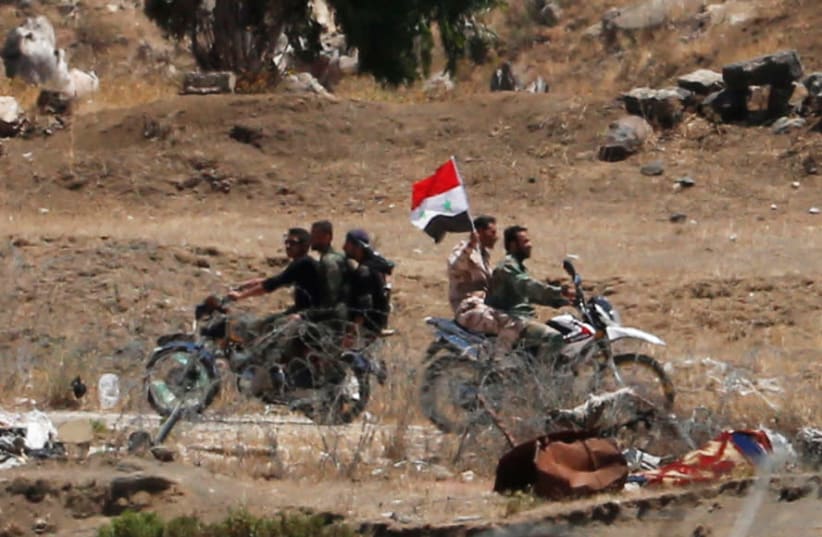This is an area that is a triangle of 500 km. on one side from the Golan to Albukamal and then 120 km. from Albukamal to Deir Ezzor. These represent two distinct areas. Albukamal to Deir Ezzor is an important corridor. It is where there are some pro-Iranian militias and Iranian presence. Reports indicate that the Afghan and Pakistan volunteers who serve with Iran’s IRGC may also be in this area. They are called Fatemyoun and Zainabiyoun. There are also Iraqi Shi’ite militias in this area.
What we know is that at the end of this triangle, near Albukamal, is the Imam Ali base where Iran has constructed an important network of warehouses over an area several dozen square kilometers in size. This area has tunnels and warehouses. In June 2018, an airstrike hit an Iraqi Kataib Hezbollah headquarters near here.Later airstrikes hit the Imam Ali base. In the fall of 2019, Iraq and Syria opened the border at Al-Qaim but the base was the center of clandestine arms trafficking to Hezbollah. The arms come through here and there are networks of Iranian-backed groups along the river through Al-Mayadin town, up to Deir Ezzor and then along various roads through Al-Sukna and Palmyra, continuing to T-4 airbase where Iran has drones and other facilities. Call this the “corridor” for Iran’s road to the sea via Iraq and Syria.
In recent days there were rumors of airstrikes at Albukamal. In addition, the Iranian IRGC Quds Force commander allegedly came to Albukamal this month and met locals. That alone is big news. And on June 23, airstrikes allegedly hit areas near Sukna, Deir Ezzor and Suwayda.
Moving along the triangle from Albukamal on the Iraqi border, heading west through the desert now towards the Golan, one eventually comes to a US anti-ISIS coalition base called al-Tanf or Tanaf.Reports have recently indicated that soldiers there experimented with anti-drone gun sights. Not much happens at this base, but there are some Syrian rebel forces and Syrian refugees nearby in the Rukban camp. This US footprint is a kind of thumb in the side of Damascus – and the Russians, Iran and Syrian regime want the US to leave.
Further to the west is the Druze district of Suwayda. Since early June, the Syrian economy has collapsed and Druze have been protesting. The Assad regime has moved around some local politicians in the last months. But the reality remains that this area is not happy with the failure of the regime to secure the future. Airstrikes on June 23 hit a hill with a radar dish near here.
Further west is Daraa, the city that was a symbol of the early protests against the Syrian regime in 2011. Divided during the Syrian civil war, it fell to the regime in the summer of 2018 along with neighboring areas. But there are tensions. The Russians were supposed to be in their area to help secure the era after the reconciliation.Syrian rebels joined the 5th Corps, a unit that was supposed to help in the reconciliation with the regime. Reports indicated that the Russians played a role in this process. On June 20 a bus of the 5th corps was blown up. At funerals for the fighters there were protests. Then on June 27 and 28, more clashes appeared to follow between the Syrian regime and locals.
What is important is to look at this as a southern triangle of uncertainty that is emerging in Syria and one that is potentially of concern to Iran, Russia, the Syrian regime, and the US and Israel. Israel has said it has carried out airstrikes in recent years in Syria, and Jerusalem has demanded Iran leave the war-torn country. The 700-900 Iranian IRGC members in Syria have reportedly been shifting around in recent months, with some asserting that they might be withdrawing a bit. But there are also claims that they are putting down roots with locals, as they have done over the years. For instance, last year a Hezbollah “killer drone” team was active near the Golan. In addition, a Hezbollah member was killed in an airstrike near the Golan earlier this year.
The recent Suwayda protests and airstrikes, the appearance of Ghaani in Albukamal and the 5th corps' troubles all seem to point to a spotlight on southern Syria that may be growing in its intensity. Until recently mostly quiet, the area is now becoming more focused upon.
